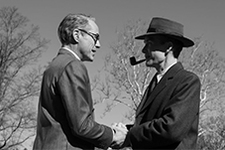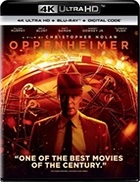Oppenheimer (4K UHD)
|  Writing about Christopher Nolan’s Dunkirk (2018) five years ago, I noted the discrepancy between my initial experience of watching the film, which felt viscerally immersive and deeply impactful, and my feelings about it several days later, which was haunted by a nagging awareness that it lacked a crucial human element. It left me not with a lasting sense of masterful engagement, but rather alienation once the initial effect wore off. I had a very different experience with Nolan’s previous film, Interstellar (2014), which I admired both during my initial screening and in the days after, but could never really love because I felt too much of the effort that went into it. For everything about it that was great and ambitious, it ultimately felt strained and ramped to such a degree that it kept me just outside of the emotional experience I should have been having. I say all that as prelude to my being pleased to report that neither of those experiences aligned with my experience of watching Nolan’s latest film, Oppenheimer, which constantly brushes up against greatness and comes as close to an outright masterpiece as Nolan has produced in years. Unlike Dunkirk, Nolan’s only other strictly historical film, Oppenheimer is rich in emotion and human complexity. And, unlike Interstellar, it doesn’t feel strained in its ambitious striving for an enormous narrative and dense thematic tapestry. Despite all the hoopla surrounding its having been shot (like so many of his previous films) in 65mm with crucial segments being project in the enormous IMAX format, Oppenheimer is at heart a character study, a deeply felt and intimate depiction of a profoundly complicated historical figure whose name is familiar to most Americans, but whose history is likely not. Thus, Oppenheimer is the best kind of historical biopic: the kind that plays on our generalized familiarity while opening up new realms of understanding and inciting curiosity to know more. Based on the voluminous, Pulitzer Prize-winning biography American Prometheus: The Triumph and Tragedy of J. Robert Oppenheimer (2005), which took authors Kai Bird and Martin Sherwin a quarter of a century to research and write, Oppenheimer unfolds like a Shakespearean tragedy reimagined for the political and technological paranoia of the Cold War. As the book weighs in at over 700 pages, I can only imagine that Nolan had to streamline much of the material for his film, which still runs a solid three hours, but never feels a minute too long. As has long been his penchant, Nolan fractures the narrative chronologically, dismantling the mostly linear chronicle of Bird and Sherwin’s biography by interweaving a variety of plotlines that unfold during different periods of the life of its titular subject, J. Robert Oppenheimer (Cillian Murphy, in his sixth collaboration with Nolan). Much of the narrative information is motivated by two very different moments of political theater: Oppenheimer’s being grilled in a closed-door 1954 hearing of the U.S. Atomic Energy Commission (AEC) by special counsel Roger Robb (Jason Clarke) in a small government office and the 1959 U.S Commerce Secretary confirmation hearing of Lewis Strauss (Robert Downey Jr.), who had tried to recruit Oppenheimer to head Princeton’s Institute for Advanced Study in 1947 and, as a founding commissioner of the AEC, later clashed with him over the development of the hydrogen bomb. Through these two events, Nolan dramatizes Oppenheimer’s fascinating history, beginning with him as a harried graduate student in the new field of theoretical physics and then a young, ambitious professor at Berkeley, where he dabbles in leftwing politics and union organizing, events that will later play into his political demonization by his critics. It is also during this time that he strikes up a sexual relationship with Jean Tatlock (Florence Pugh), an emotionally unstable psychiatrist involved with the communist party, and his eventual wife, Kitty (Emily Blunt), another communist organizer married to another Berkeley professor. The middle section of the film details Oppenheimer’s management of the Manhattan Project, the massive, secret government research team that developed the first atomic bombs during World War II. The project was headed by General Leslie Groves (Matt Damon), one of the few military men who seemed to understand Oppenheimer and how he worked (the odd-couple relationship between Oppenheimer and Groves is one of the film’s most surprisingly deft and humane touches, and both Murphy and Damon are fantastic). Unfortunately, much of Oppenheimer’s life was destined to be misunderstood and misrepresented, and the film presents him as a kind of political martyr whose blatant persecution for committing the sin of wavering in his commitment to arms, arms, and bigger arms marked the fissure that broke open a chasm between science and government. Based largely on his moral reckoning with what he had wrought and his fervent desire to stop the development of even more devastating weapons of war, Oppenheimer was branded a communist and stripped of his security clearance, a political analogue to Prometheus’s punishment by Zeus for bring fire to humanity (I have to admit that I wish Nolan had kept the source biography’s title, which is all too perfect and would have separated his film from the 1980 seven-part British miniseries Oppenheimer). Nolan and Dutch-Swedish cinematographer Hoyte Van Hoytema, who has shot all of Nolan’s films since Interstellar, give Oppenheimer a sense of visual grandeur that is enhanced by both the use of large-format celluloid and the decision to mix color and black-and-white imagery (a nod, perhaps, to the bracing historical films of Oliver Stone, who not incidentally was at one point attached to an Oppenheimer biopic). From the research labs at Berkeley, to the desolate vistas of New Mexico where Oppenheimer had an entire town built for the Manhattan Project, to the floor of the Senate, everything feels large and heavy, as if history itself is bearing down. Nolan also intensifies the film’s subjectivity, frequently taking us into Oppenheimer’s emotional experience, never so intensely as when he is giving what should be a celebratory speech after the successful deployment of the two atomic bombs he helped develop, but is instead haunted by the specter of mass death they unleashed (the film’s protracted use of silence is devastating). However, at times the film’s shifts into the subjective don’t entirely work, such as an awkward sequence in which Oppenheimer is being grilled about his extramarital relationship with Jean Tatlock and Kitty, who is sitting right behind him, imagines the naked woman grinding on top of her husband at the table. It is an unnecessary flourish, especially since all of the film’s other subjective moments belong to Oppenheimer. Yet, even in the moments that don’t entirely work, Oppenheimer still feels like a towering achievement, a film that melds dense emotional textures with a wide swath of crucial 20th-century history and the attendant moral and political quagmires into which Oppenheimer’s scientific achievements led us. Rarely has a film made theoretical physics feel so tangible to the non-scientifically inclined (like myself) or turned the spectacle of mass destruction into a horrible-poetic elegy for the hope that humanity might not destroy itself. The film is an accumulation of details—physical, historical, scientific, and personal—and each scene feels essential, even if at times we aren’t sure whose agenda is being served or what the significance of a character’s actions are. Befitting Nolan’s fascination with narrative twists and interlocking moments, much of Oppenheimer hinges on an unheard line of dialogue spoken by Albert Einstein (Tom Conti) to Oppenheimer by a pond on the Princeton camps, a nod to both the secrecy that defined so much of Oppenheimer’s life and the frequently heard complaints that a lot of dialogue in Nolan’s films is indecipherable. That is not the case here, and at times the film deploys silence with a deafening roar of significance. Oppenheimer is a monumental film about a monumental (and monumentally flawed) historical figure, the kind of film that opens our eyes to the hidden complexities of familiar history lessons and a reminds us of how heroism is all too often a product of a specific moment, subject to rebuke when it no longer suits the needs of those in power.
Copyright © 2023 James Kendrick Thoughts? E-mail James Kendrick All images copyright © Universal Home Entertainment | |||||||||||||||||||||||||||||
Overall Rating: 


 (4)
(4)


